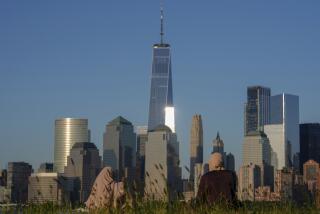Fuel Line May Be Factor in N.Y. Jet Crash
- Share via
NEW YORK — An airliner that veered off a runway and erupted into flames left a trail of fuel behind, suggesting that a ruptured fuel line may have fed the blaze, according to a preliminary report.
Fuel stretched about 2,500 feet behind the site where TWA Flight 843 came to rest Thursday, said a Port Authority police official who spoke on the condition of anonymity. The Port Authority’s preliminary report on the accident said a rear fuel line to the plane may have ruptured, the official said.
Crews in yellow rain suits worked in a driving rain Friday to stabilize the charred wreckage, from which the 292 people aboard scrambled to escape.
The Lockheed-built L-1011, bound for San Francisco, was leaving John F. Kennedy International Airport on Thursday afternoon when the pilot learned from the control tower that flames were shooting from the rear engine and aborted the takeoff.
All aboard escaped through emergency exits as flames engulfed the back half of the plane. Fifty-five people were injured, none seriously.
Gregory Feith, a National Transportation Safety Board inspector, said Friday an engine problem may have preceded the fire. But Thomas Conroy, who is heading the investigation for the safety board, said it was too early to pinpoint the cause.
“We’ve just gotten here,” he said as investigators collected and analyzed pieces of wreckage. The plane’s flight and voice recorders were sent to Washington.
The L-1011 has a good safety record, aerospace experts said. But twice in the past two years, L-1011 engines have spurted flames: at Kennedy on April 16, 1992, and at Boston’s Logan Airport on March 26, 1990. No serious injuries were reported in either case.
Passengers who watched from the Tarmac as flames enveloped the rear half of their plane Thursday praised the 12-member crew for getting them out.
The crew did “a fabulous job,” said Bill Kistner, a retired police officer from San Jose, Calif. “People were panicking. We were all trying to get away from the flames. The captain was helping everyone out. He was the last to go.”
“The evacuation went extremely well,” added Frank Huever, chief supervisor of operations for the Port Authority, which runs the airport. “The pilot really knew what he was doing.”
The Federal Aviation Administration identified the pilot as William Shelby Kinkead of the British Virgin Islands.
The Port Authority report said the pilot had walked the length of the aircraft to make sure everyone was out before he disembarked.
Laurent Ceuwel, a 13-year-old Belgian exchange student on the plane, had a message for him: “Thank you for saving us, you did a great job.”
As the plane was taking off at about 5:40 p.m. EDT, the control tower radioed that flames could be seen shooting from the rear engine.
As the pilot aborted the takeoff, the plane bounced back onto the runway. As it rolled toward a stop, it veered to one side and crashed through a barrier, coming to rest about 100 feet from the runway.
But the ordeal was far from over. When a flight attendant opened a rear exit, a ball of flame roared into the cabin, said passenger Julia Elhauge of Berkeley, Calif.
With four rear exits blocked by smoke and flames, passengers made their way out four front exits.
More to Read
Sign up for Essential California
The most important California stories and recommendations in your inbox every morning.
You may occasionally receive promotional content from the Los Angeles Times.













